Mental Health and Wellness Program: Workplace Case Study and Analysis
VerifiedAdded on 2023/06/08
|8
|2229
|278
Report
AI Summary
This report provides a comprehensive analysis of workplace mental health and wellness programs. It begins by outlining the key components typically found in such programs, including vision and mission statements, goals, objectives, timelines, budgets, communication plans, implementation strategies, and evaluation methods. The report then examines case studies of mental health initiatives at St. Joseph's Healthcare Hamilton, Delta Hotels, and Rodale, detailing their specific programs, activities, and outcomes. The analysis covers the effectiveness of these programs, including their impact on employee engagement, stress levels, and overall wellbeing. The second part of the report explores the development and implementation of a workplace mental health and wellness program, including team composition, goals, outcomes, and strategies for identifying employee needs and expectations. The report emphasizes the importance of measurable goals, employee involvement, and ongoing evaluation to ensure program success, covering areas like fitness activities, mental health support, and team-building initiatives. The report also discusses the significance of EAP programs, cultural considerations, and gender/sexual orientation-specific components in promoting a holistic approach to workplace mental health.
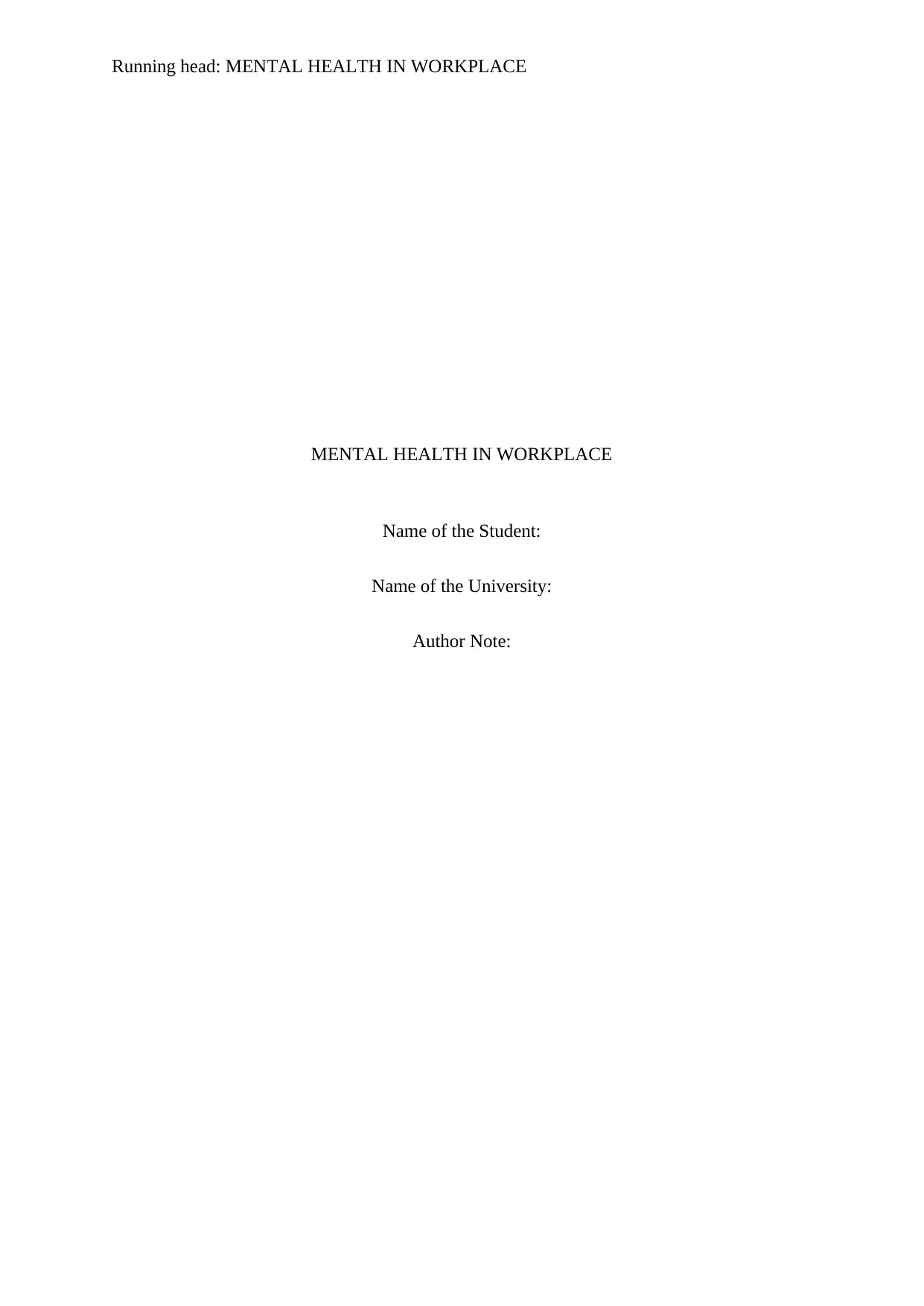
Running head: MENTAL HEALTH IN WORKPLACE
MENTAL HEALTH IN WORKPLACE
Name of the Student:
Name of the University:
Author Note:
MENTAL HEALTH IN WORKPLACE
Name of the Student:
Name of the University:
Author Note:
Paraphrase This Document
Need a fresh take? Get an instant paraphrase of this document with our AI Paraphraser
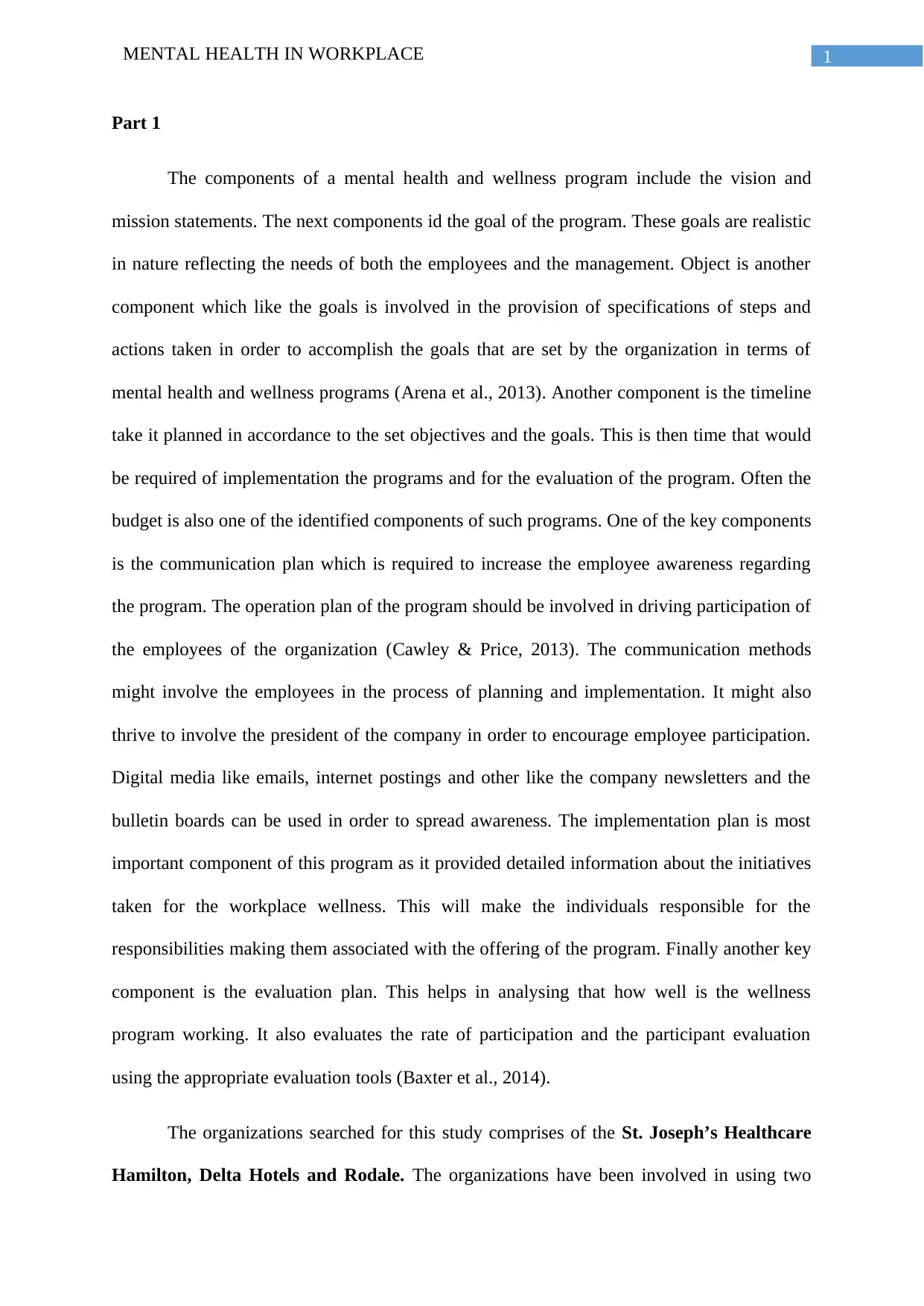
1MENTAL HEALTH IN WORKPLACE
Part 1
The components of a mental health and wellness program include the vision and
mission statements. The next components id the goal of the program. These goals are realistic
in nature reflecting the needs of both the employees and the management. Object is another
component which like the goals is involved in the provision of specifications of steps and
actions taken in order to accomplish the goals that are set by the organization in terms of
mental health and wellness programs (Arena et al., 2013). Another component is the timeline
take it planned in accordance to the set objectives and the goals. This is then time that would
be required of implementation the programs and for the evaluation of the program. Often the
budget is also one of the identified components of such programs. One of the key components
is the communication plan which is required to increase the employee awareness regarding
the program. The operation plan of the program should be involved in driving participation of
the employees of the organization (Cawley & Price, 2013). The communication methods
might involve the employees in the process of planning and implementation. It might also
thrive to involve the president of the company in order to encourage employee participation.
Digital media like emails, internet postings and other like the company newsletters and the
bulletin boards can be used in order to spread awareness. The implementation plan is most
important component of this program as it provided detailed information about the initiatives
taken for the workplace wellness. This will make the individuals responsible for the
responsibilities making them associated with the offering of the program. Finally another key
component is the evaluation plan. This helps in analysing that how well is the wellness
program working. It also evaluates the rate of participation and the participant evaluation
using the appropriate evaluation tools (Baxter et al., 2014).
The organizations searched for this study comprises of the St. Joseph’s Healthcare
Hamilton, Delta Hotels and Rodale. The organizations have been involved in using two
Part 1
The components of a mental health and wellness program include the vision and
mission statements. The next components id the goal of the program. These goals are realistic
in nature reflecting the needs of both the employees and the management. Object is another
component which like the goals is involved in the provision of specifications of steps and
actions taken in order to accomplish the goals that are set by the organization in terms of
mental health and wellness programs (Arena et al., 2013). Another component is the timeline
take it planned in accordance to the set objectives and the goals. This is then time that would
be required of implementation the programs and for the evaluation of the program. Often the
budget is also one of the identified components of such programs. One of the key components
is the communication plan which is required to increase the employee awareness regarding
the program. The operation plan of the program should be involved in driving participation of
the employees of the organization (Cawley & Price, 2013). The communication methods
might involve the employees in the process of planning and implementation. It might also
thrive to involve the president of the company in order to encourage employee participation.
Digital media like emails, internet postings and other like the company newsletters and the
bulletin boards can be used in order to spread awareness. The implementation plan is most
important component of this program as it provided detailed information about the initiatives
taken for the workplace wellness. This will make the individuals responsible for the
responsibilities making them associated with the offering of the program. Finally another key
component is the evaluation plan. This helps in analysing that how well is the wellness
program working. It also evaluates the rate of participation and the participant evaluation
using the appropriate evaluation tools (Baxter et al., 2014).
The organizations searched for this study comprises of the St. Joseph’s Healthcare
Hamilton, Delta Hotels and Rodale. The organizations have been involved in using two
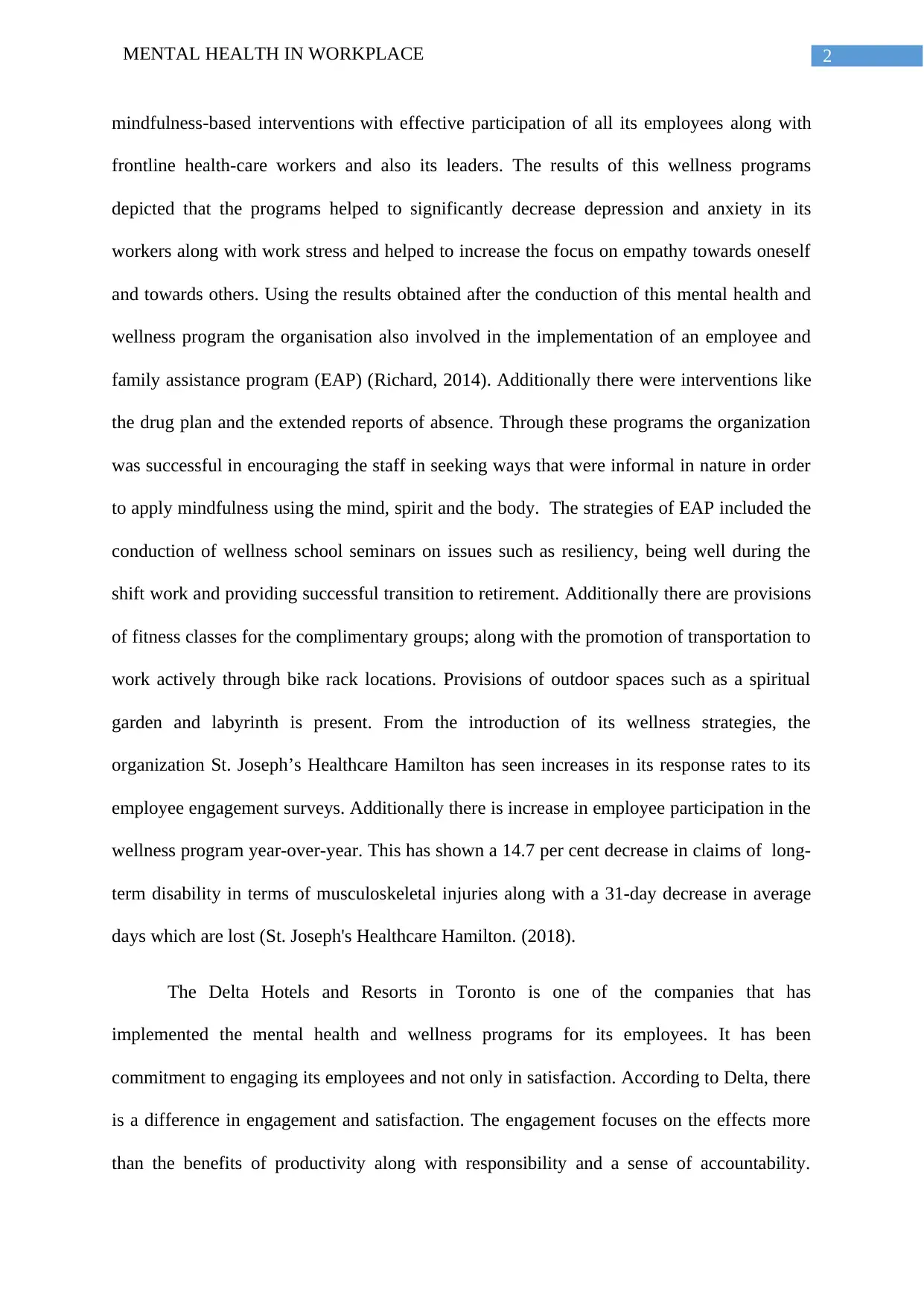
2MENTAL HEALTH IN WORKPLACE
mindfulness-based interventions with effective participation of all its employees along with
frontline health-care workers and also its leaders. The results of this wellness programs
depicted that the programs helped to significantly decrease depression and anxiety in its
workers along with work stress and helped to increase the focus on empathy towards oneself
and towards others. Using the results obtained after the conduction of this mental health and
wellness program the organisation also involved in the implementation of an employee and
family assistance program (EAP) (Richard, 2014). Additionally there were interventions like
the drug plan and the extended reports of absence. Through these programs the organization
was successful in encouraging the staff in seeking ways that were informal in nature in order
to apply mindfulness using the mind, spirit and the body. The strategies of EAP included the
conduction of wellness school seminars on issues such as resiliency, being well during the
shift work and providing successful transition to retirement. Additionally there are provisions
of fitness classes for the complimentary groups; along with the promotion of transportation to
work actively through bike rack locations. Provisions of outdoor spaces such as a spiritual
garden and labyrinth is present. From the introduction of its wellness strategies, the
organization St. Joseph’s Healthcare Hamilton has seen increases in its response rates to its
employee engagement surveys. Additionally there is increase in employee participation in the
wellness program year-over-year. This has shown a 14.7 per cent decrease in claims of long-
term disability in terms of musculoskeletal injuries along with a 31-day decrease in average
days which are lost (St. Joseph's Healthcare Hamilton. (2018).
The Delta Hotels and Resorts in Toronto is one of the companies that has
implemented the mental health and wellness programs for its employees. It has been
commitment to engaging its employees and not only in satisfaction. According to Delta, there
is a difference in engagement and satisfaction. The engagement focuses on the effects more
than the benefits of productivity along with responsibility and a sense of accountability.
mindfulness-based interventions with effective participation of all its employees along with
frontline health-care workers and also its leaders. The results of this wellness programs
depicted that the programs helped to significantly decrease depression and anxiety in its
workers along with work stress and helped to increase the focus on empathy towards oneself
and towards others. Using the results obtained after the conduction of this mental health and
wellness program the organisation also involved in the implementation of an employee and
family assistance program (EAP) (Richard, 2014). Additionally there were interventions like
the drug plan and the extended reports of absence. Through these programs the organization
was successful in encouraging the staff in seeking ways that were informal in nature in order
to apply mindfulness using the mind, spirit and the body. The strategies of EAP included the
conduction of wellness school seminars on issues such as resiliency, being well during the
shift work and providing successful transition to retirement. Additionally there are provisions
of fitness classes for the complimentary groups; along with the promotion of transportation to
work actively through bike rack locations. Provisions of outdoor spaces such as a spiritual
garden and labyrinth is present. From the introduction of its wellness strategies, the
organization St. Joseph’s Healthcare Hamilton has seen increases in its response rates to its
employee engagement surveys. Additionally there is increase in employee participation in the
wellness program year-over-year. This has shown a 14.7 per cent decrease in claims of long-
term disability in terms of musculoskeletal injuries along with a 31-day decrease in average
days which are lost (St. Joseph's Healthcare Hamilton. (2018).
The Delta Hotels and Resorts in Toronto is one of the companies that has
implemented the mental health and wellness programs for its employees. It has been
commitment to engaging its employees and not only in satisfaction. According to Delta, there
is a difference in engagement and satisfaction. The engagement focuses on the effects more
than the benefits of productivity along with responsibility and a sense of accountability.
⊘ This is a preview!⊘
Do you want full access?
Subscribe today to unlock all pages.

Trusted by 1+ million students worldwide
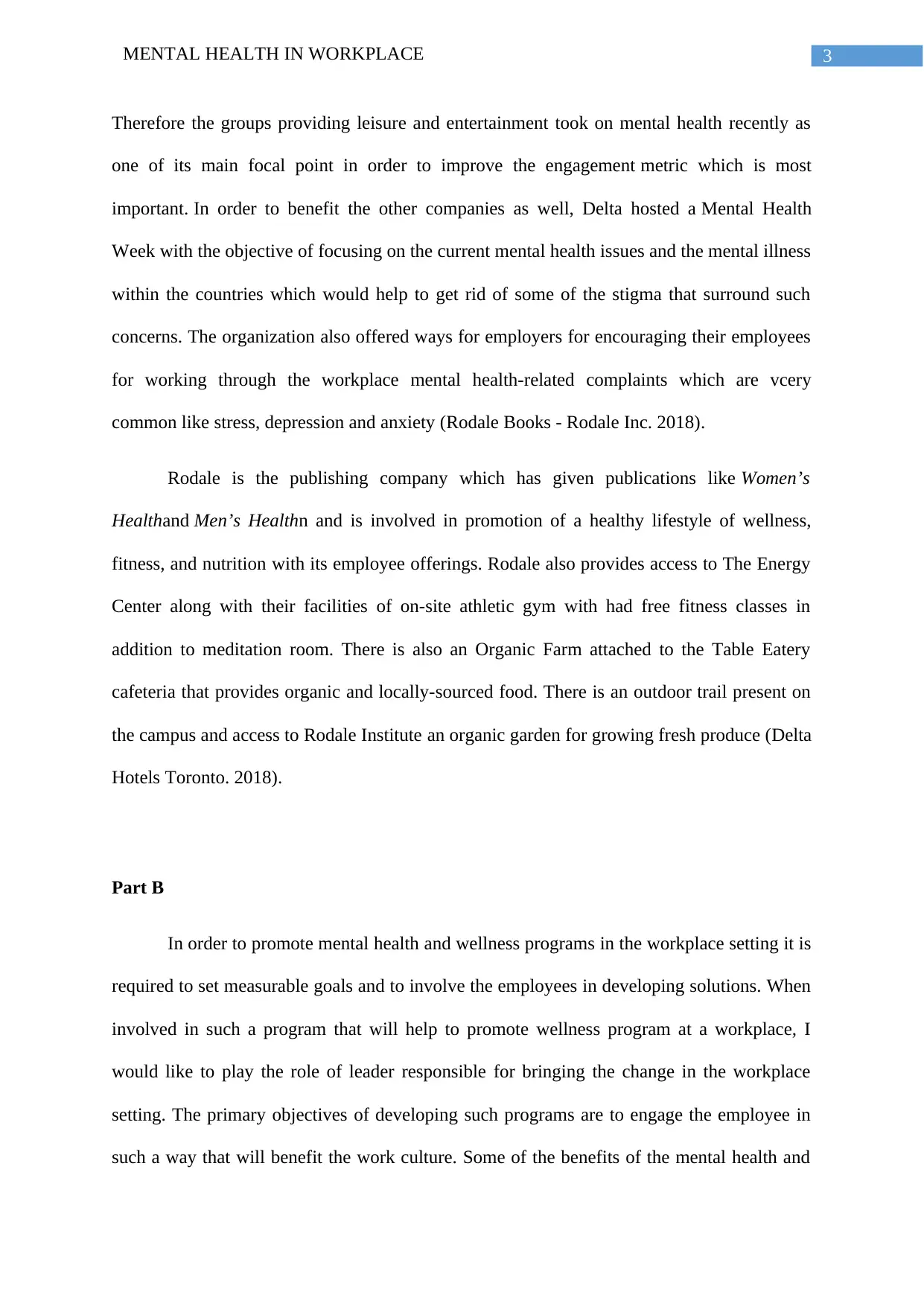
3MENTAL HEALTH IN WORKPLACE
Therefore the groups providing leisure and entertainment took on mental health recently as
one of its main focal point in order to improve the engagement metric which is most
important. In order to benefit the other companies as well, Delta hosted a Mental Health
Week with the objective of focusing on the current mental health issues and the mental illness
within the countries which would help to get rid of some of the stigma that surround such
concerns. The organization also offered ways for employers for encouraging their employees
for working through the workplace mental health-related complaints which are vcery
common like stress, depression and anxiety (Rodale Books - Rodale Inc. 2018).
Rodale is the publishing company which has given publications like Women’s
Healthand Men’s Healthn and is involved in promotion of a healthy lifestyle of wellness,
fitness, and nutrition with its employee offerings. Rodale also provides access to The Energy
Center along with their facilities of on-site athletic gym with had free fitness classes in
addition to meditation room. There is also an Organic Farm attached to the Table Eatery
cafeteria that provides organic and locally-sourced food. There is an outdoor trail present on
the campus and access to Rodale Institute an organic garden for growing fresh produce (Delta
Hotels Toronto. 2018).
Part B
In order to promote mental health and wellness programs in the workplace setting it is
required to set measurable goals and to involve the employees in developing solutions. When
involved in such a program that will help to promote wellness program at a workplace, I
would like to play the role of leader responsible for bringing the change in the workplace
setting. The primary objectives of developing such programs are to engage the employee in
such a way that will benefit the work culture. Some of the benefits of the mental health and
Therefore the groups providing leisure and entertainment took on mental health recently as
one of its main focal point in order to improve the engagement metric which is most
important. In order to benefit the other companies as well, Delta hosted a Mental Health
Week with the objective of focusing on the current mental health issues and the mental illness
within the countries which would help to get rid of some of the stigma that surround such
concerns. The organization also offered ways for employers for encouraging their employees
for working through the workplace mental health-related complaints which are vcery
common like stress, depression and anxiety (Rodale Books - Rodale Inc. 2018).
Rodale is the publishing company which has given publications like Women’s
Healthand Men’s Healthn and is involved in promotion of a healthy lifestyle of wellness,
fitness, and nutrition with its employee offerings. Rodale also provides access to The Energy
Center along with their facilities of on-site athletic gym with had free fitness classes in
addition to meditation room. There is also an Organic Farm attached to the Table Eatery
cafeteria that provides organic and locally-sourced food. There is an outdoor trail present on
the campus and access to Rodale Institute an organic garden for growing fresh produce (Delta
Hotels Toronto. 2018).
Part B
In order to promote mental health and wellness programs in the workplace setting it is
required to set measurable goals and to involve the employees in developing solutions. When
involved in such a program that will help to promote wellness program at a workplace, I
would like to play the role of leader responsible for bringing the change in the workplace
setting. The primary objectives of developing such programs are to engage the employee in
such a way that will benefit the work culture. Some of the benefits of the mental health and
Paraphrase This Document
Need a fresh take? Get an instant paraphrase of this document with our AI Paraphraser
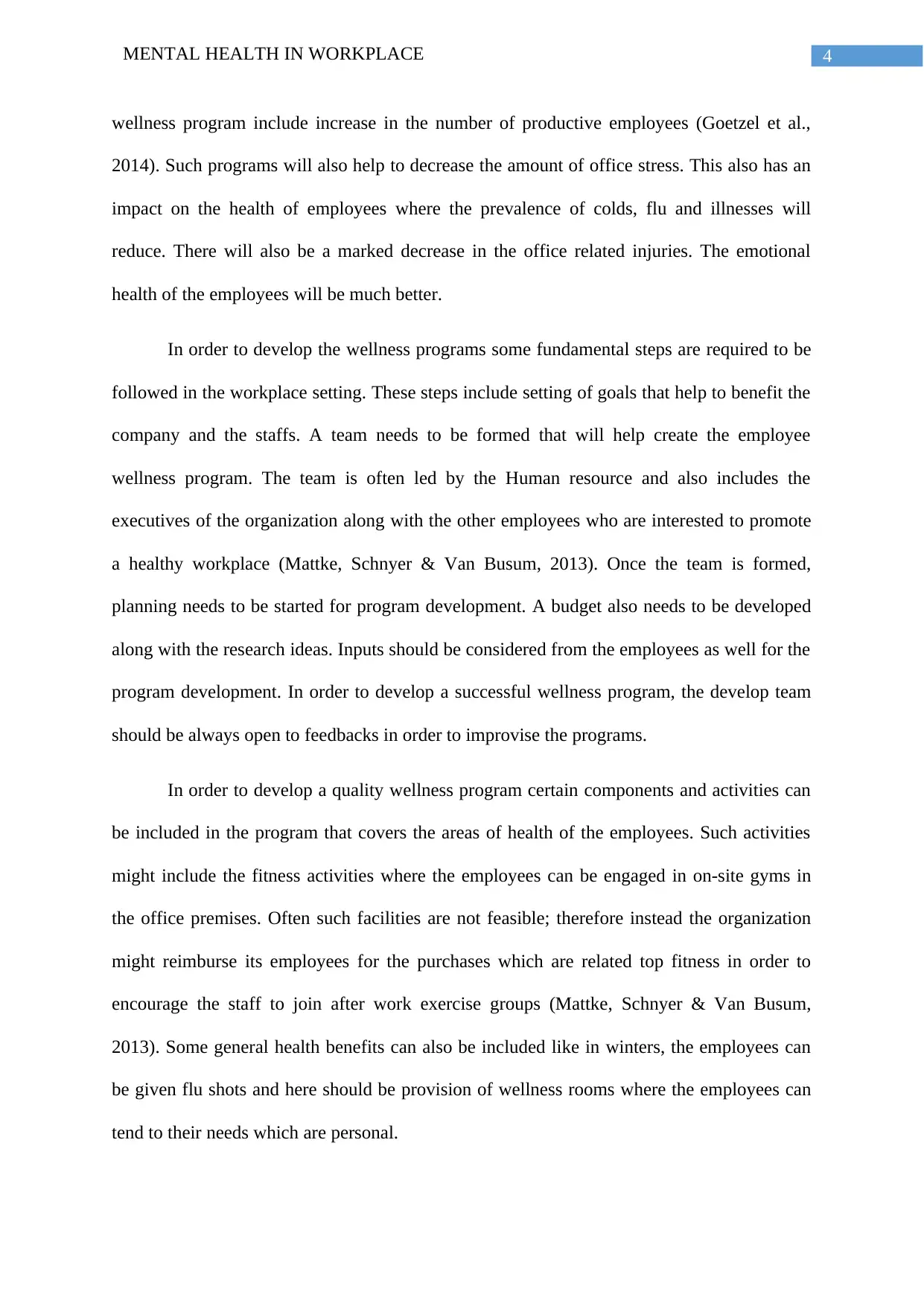
4MENTAL HEALTH IN WORKPLACE
wellness program include increase in the number of productive employees (Goetzel et al.,
2014). Such programs will also help to decrease the amount of office stress. This also has an
impact on the health of employees where the prevalence of colds, flu and illnesses will
reduce. There will also be a marked decrease in the office related injuries. The emotional
health of the employees will be much better.
In order to develop the wellness programs some fundamental steps are required to be
followed in the workplace setting. These steps include setting of goals that help to benefit the
company and the staffs. A team needs to be formed that will help create the employee
wellness program. The team is often led by the Human resource and also includes the
executives of the organization along with the other employees who are interested to promote
a healthy workplace (Mattke, Schnyer & Van Busum, 2013). Once the team is formed,
planning needs to be started for program development. A budget also needs to be developed
along with the research ideas. Inputs should be considered from the employees as well for the
program development. In order to develop a successful wellness program, the develop team
should be always open to feedbacks in order to improvise the programs.
In order to develop a quality wellness program certain components and activities can
be included in the program that covers the areas of health of the employees. Such activities
might include the fitness activities where the employees can be engaged in on-site gyms in
the office premises. Often such facilities are not feasible; therefore instead the organization
might reimburse its employees for the purchases which are related top fitness in order to
encourage the staff to join after work exercise groups (Mattke, Schnyer & Van Busum,
2013). Some general health benefits can also be included like in winters, the employees can
be given flu shots and here should be provision of wellness rooms where the employees can
tend to their needs which are personal.
wellness program include increase in the number of productive employees (Goetzel et al.,
2014). Such programs will also help to decrease the amount of office stress. This also has an
impact on the health of employees where the prevalence of colds, flu and illnesses will
reduce. There will also be a marked decrease in the office related injuries. The emotional
health of the employees will be much better.
In order to develop the wellness programs some fundamental steps are required to be
followed in the workplace setting. These steps include setting of goals that help to benefit the
company and the staffs. A team needs to be formed that will help create the employee
wellness program. The team is often led by the Human resource and also includes the
executives of the organization along with the other employees who are interested to promote
a healthy workplace (Mattke, Schnyer & Van Busum, 2013). Once the team is formed,
planning needs to be started for program development. A budget also needs to be developed
along with the research ideas. Inputs should be considered from the employees as well for the
program development. In order to develop a successful wellness program, the develop team
should be always open to feedbacks in order to improvise the programs.
In order to develop a quality wellness program certain components and activities can
be included in the program that covers the areas of health of the employees. Such activities
might include the fitness activities where the employees can be engaged in on-site gyms in
the office premises. Often such facilities are not feasible; therefore instead the organization
might reimburse its employees for the purchases which are related top fitness in order to
encourage the staff to join after work exercise groups (Mattke, Schnyer & Van Busum,
2013). Some general health benefits can also be included like in winters, the employees can
be given flu shots and here should be provision of wellness rooms where the employees can
tend to their needs which are personal.
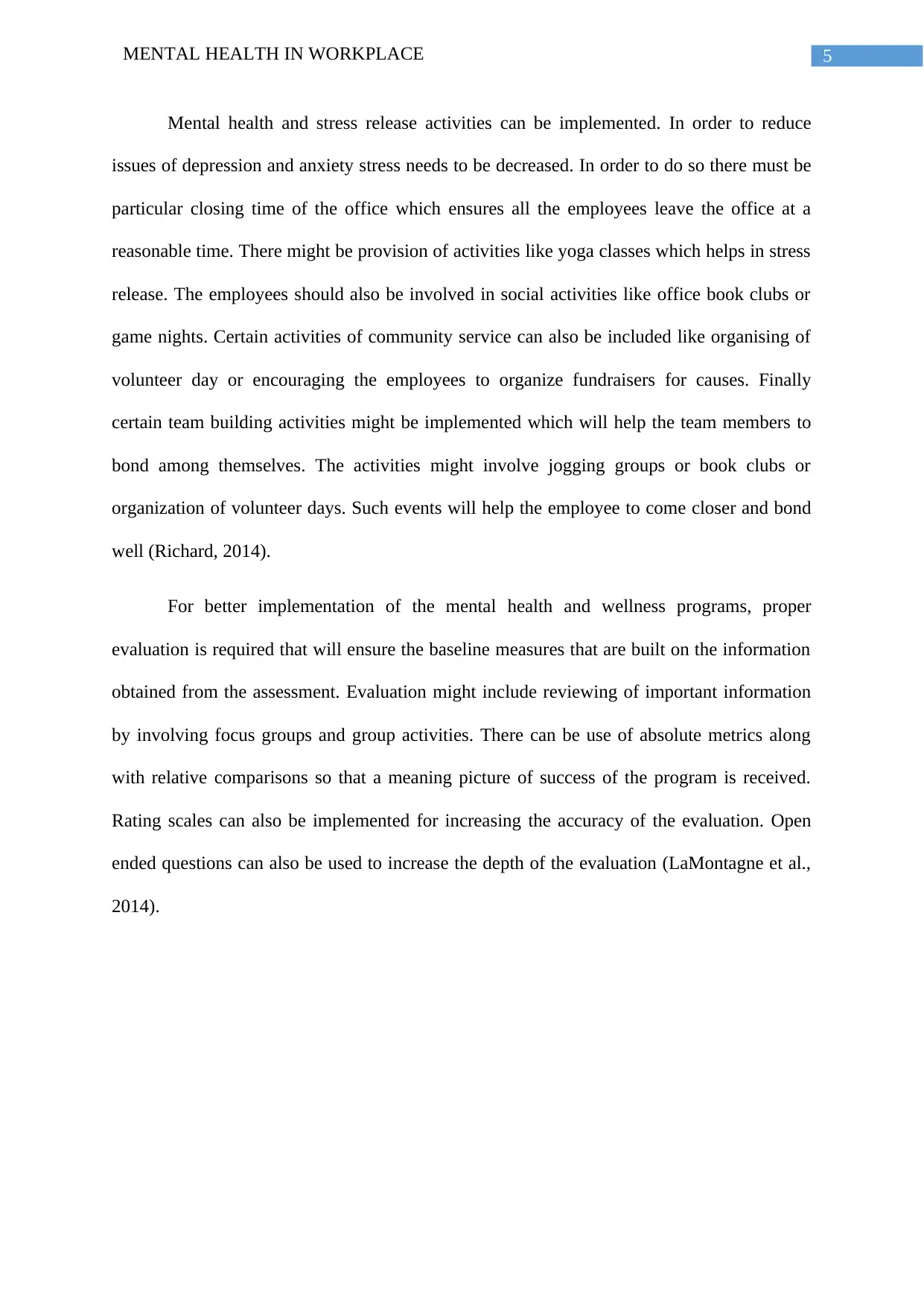
5MENTAL HEALTH IN WORKPLACE
Mental health and stress release activities can be implemented. In order to reduce
issues of depression and anxiety stress needs to be decreased. In order to do so there must be
particular closing time of the office which ensures all the employees leave the office at a
reasonable time. There might be provision of activities like yoga classes which helps in stress
release. The employees should also be involved in social activities like office book clubs or
game nights. Certain activities of community service can also be included like organising of
volunteer day or encouraging the employees to organize fundraisers for causes. Finally
certain team building activities might be implemented which will help the team members to
bond among themselves. The activities might involve jogging groups or book clubs or
organization of volunteer days. Such events will help the employee to come closer and bond
well (Richard, 2014).
For better implementation of the mental health and wellness programs, proper
evaluation is required that will ensure the baseline measures that are built on the information
obtained from the assessment. Evaluation might include reviewing of important information
by involving focus groups and group activities. There can be use of absolute metrics along
with relative comparisons so that a meaning picture of success of the program is received.
Rating scales can also be implemented for increasing the accuracy of the evaluation. Open
ended questions can also be used to increase the depth of the evaluation (LaMontagne et al.,
2014).
Mental health and stress release activities can be implemented. In order to reduce
issues of depression and anxiety stress needs to be decreased. In order to do so there must be
particular closing time of the office which ensures all the employees leave the office at a
reasonable time. There might be provision of activities like yoga classes which helps in stress
release. The employees should also be involved in social activities like office book clubs or
game nights. Certain activities of community service can also be included like organising of
volunteer day or encouraging the employees to organize fundraisers for causes. Finally
certain team building activities might be implemented which will help the team members to
bond among themselves. The activities might involve jogging groups or book clubs or
organization of volunteer days. Such events will help the employee to come closer and bond
well (Richard, 2014).
For better implementation of the mental health and wellness programs, proper
evaluation is required that will ensure the baseline measures that are built on the information
obtained from the assessment. Evaluation might include reviewing of important information
by involving focus groups and group activities. There can be use of absolute metrics along
with relative comparisons so that a meaning picture of success of the program is received.
Rating scales can also be implemented for increasing the accuracy of the evaluation. Open
ended questions can also be used to increase the depth of the evaluation (LaMontagne et al.,
2014).
⊘ This is a preview!⊘
Do you want full access?
Subscribe today to unlock all pages.

Trusted by 1+ million students worldwide
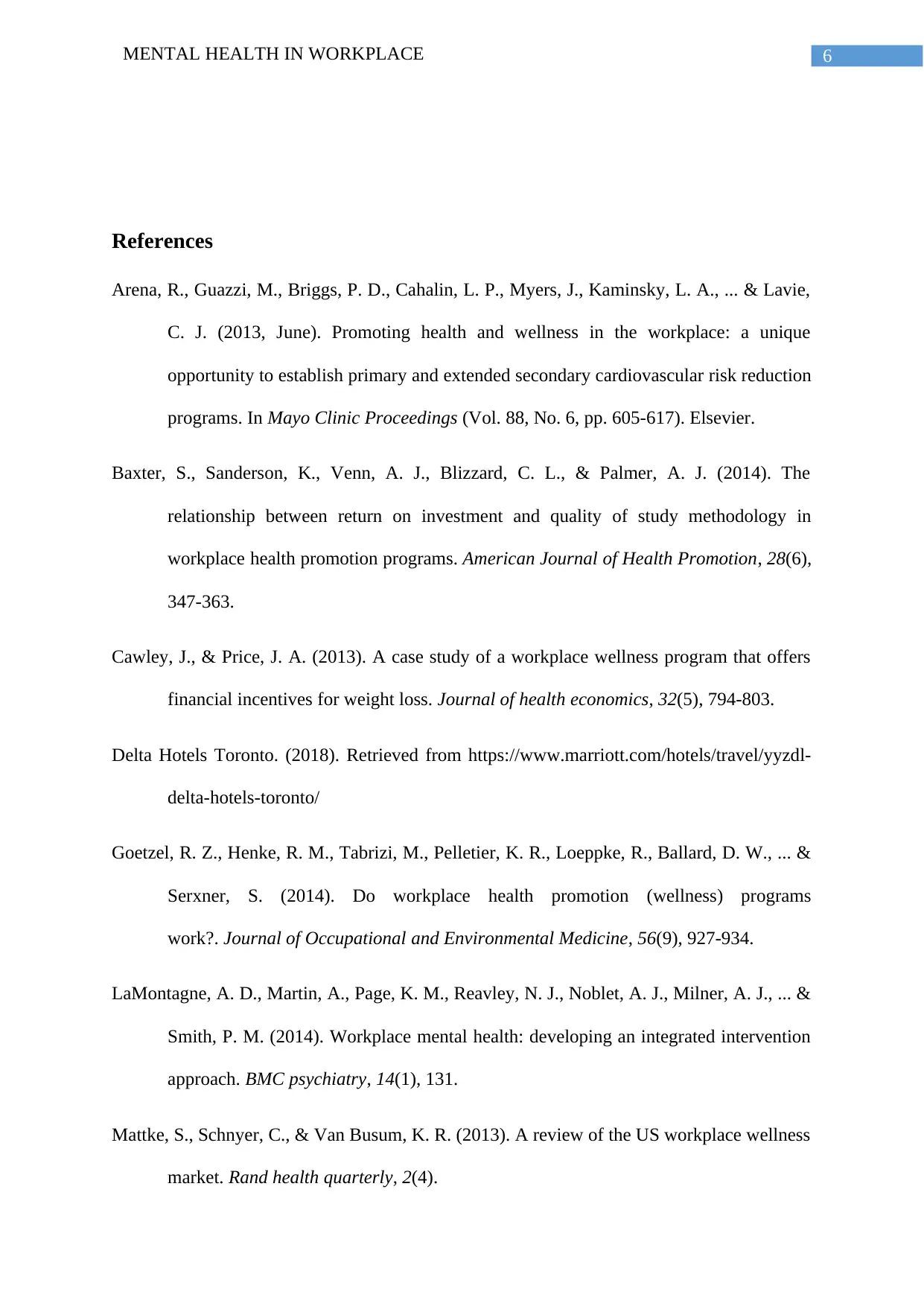
6MENTAL HEALTH IN WORKPLACE
References
Arena, R., Guazzi, M., Briggs, P. D., Cahalin, L. P., Myers, J., Kaminsky, L. A., ... & Lavie,
C. J. (2013, June). Promoting health and wellness in the workplace: a unique
opportunity to establish primary and extended secondary cardiovascular risk reduction
programs. In Mayo Clinic Proceedings (Vol. 88, No. 6, pp. 605-617). Elsevier.
Baxter, S., Sanderson, K., Venn, A. J., Blizzard, C. L., & Palmer, A. J. (2014). The
relationship between return on investment and quality of study methodology in
workplace health promotion programs. American Journal of Health Promotion, 28(6),
347-363.
Cawley, J., & Price, J. A. (2013). A case study of a workplace wellness program that offers
financial incentives for weight loss. Journal of health economics, 32(5), 794-803.
Delta Hotels Toronto. (2018). Retrieved from https://www.marriott.com/hotels/travel/yyzdl-
delta-hotels-toronto/
Goetzel, R. Z., Henke, R. M., Tabrizi, M., Pelletier, K. R., Loeppke, R., Ballard, D. W., ... &
Serxner, S. (2014). Do workplace health promotion (wellness) programs
work?. Journal of Occupational and Environmental Medicine, 56(9), 927-934.
LaMontagne, A. D., Martin, A., Page, K. M., Reavley, N. J., Noblet, A. J., Milner, A. J., ... &
Smith, P. M. (2014). Workplace mental health: developing an integrated intervention
approach. BMC psychiatry, 14(1), 131.
Mattke, S., Schnyer, C., & Van Busum, K. R. (2013). A review of the US workplace wellness
market. Rand health quarterly, 2(4).
References
Arena, R., Guazzi, M., Briggs, P. D., Cahalin, L. P., Myers, J., Kaminsky, L. A., ... & Lavie,
C. J. (2013, June). Promoting health and wellness in the workplace: a unique
opportunity to establish primary and extended secondary cardiovascular risk reduction
programs. In Mayo Clinic Proceedings (Vol. 88, No. 6, pp. 605-617). Elsevier.
Baxter, S., Sanderson, K., Venn, A. J., Blizzard, C. L., & Palmer, A. J. (2014). The
relationship between return on investment and quality of study methodology in
workplace health promotion programs. American Journal of Health Promotion, 28(6),
347-363.
Cawley, J., & Price, J. A. (2013). A case study of a workplace wellness program that offers
financial incentives for weight loss. Journal of health economics, 32(5), 794-803.
Delta Hotels Toronto. (2018). Retrieved from https://www.marriott.com/hotels/travel/yyzdl-
delta-hotels-toronto/
Goetzel, R. Z., Henke, R. M., Tabrizi, M., Pelletier, K. R., Loeppke, R., Ballard, D. W., ... &
Serxner, S. (2014). Do workplace health promotion (wellness) programs
work?. Journal of Occupational and Environmental Medicine, 56(9), 927-934.
LaMontagne, A. D., Martin, A., Page, K. M., Reavley, N. J., Noblet, A. J., Milner, A. J., ... &
Smith, P. M. (2014). Workplace mental health: developing an integrated intervention
approach. BMC psychiatry, 14(1), 131.
Mattke, S., Schnyer, C., & Van Busum, K. R. (2013). A review of the US workplace wellness
market. Rand health quarterly, 2(4).
Paraphrase This Document
Need a fresh take? Get an instant paraphrase of this document with our AI Paraphraser
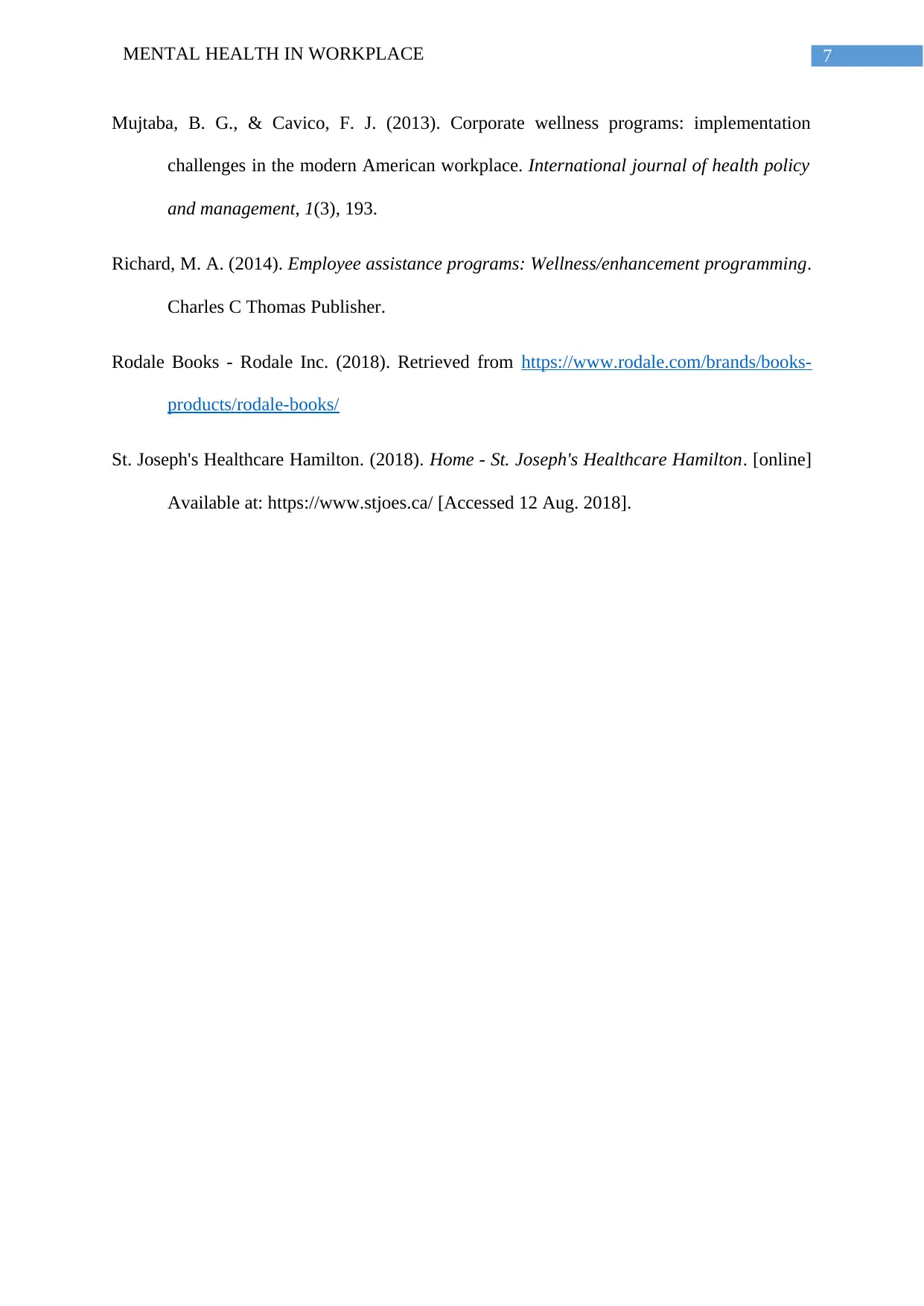
7MENTAL HEALTH IN WORKPLACE
Mujtaba, B. G., & Cavico, F. J. (2013). Corporate wellness programs: implementation
challenges in the modern American workplace. International journal of health policy
and management, 1(3), 193.
Richard, M. A. (2014). Employee assistance programs: Wellness/enhancement programming.
Charles C Thomas Publisher.
Rodale Books - Rodale Inc. (2018). Retrieved from https://www.rodale.com/brands/books-
products/rodale-books/
St. Joseph's Healthcare Hamilton. (2018). Home - St. Joseph's Healthcare Hamilton. [online]
Available at: https://www.stjoes.ca/ [Accessed 12 Aug. 2018].
Mujtaba, B. G., & Cavico, F. J. (2013). Corporate wellness programs: implementation
challenges in the modern American workplace. International journal of health policy
and management, 1(3), 193.
Richard, M. A. (2014). Employee assistance programs: Wellness/enhancement programming.
Charles C Thomas Publisher.
Rodale Books - Rodale Inc. (2018). Retrieved from https://www.rodale.com/brands/books-
products/rodale-books/
St. Joseph's Healthcare Hamilton. (2018). Home - St. Joseph's Healthcare Hamilton. [online]
Available at: https://www.stjoes.ca/ [Accessed 12 Aug. 2018].
1 out of 8
Related Documents
Your All-in-One AI-Powered Toolkit for Academic Success.
+13062052269
info@desklib.com
Available 24*7 on WhatsApp / Email
![[object Object]](/_next/static/media/star-bottom.7253800d.svg)
Unlock your academic potential
Copyright © 2020–2025 A2Z Services. All Rights Reserved. Developed and managed by ZUCOL.




